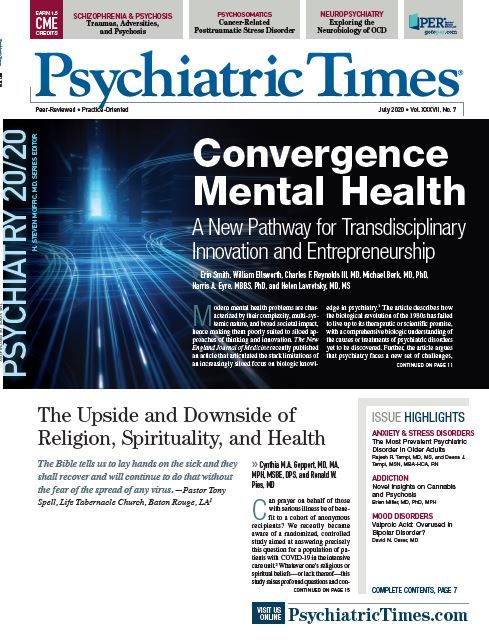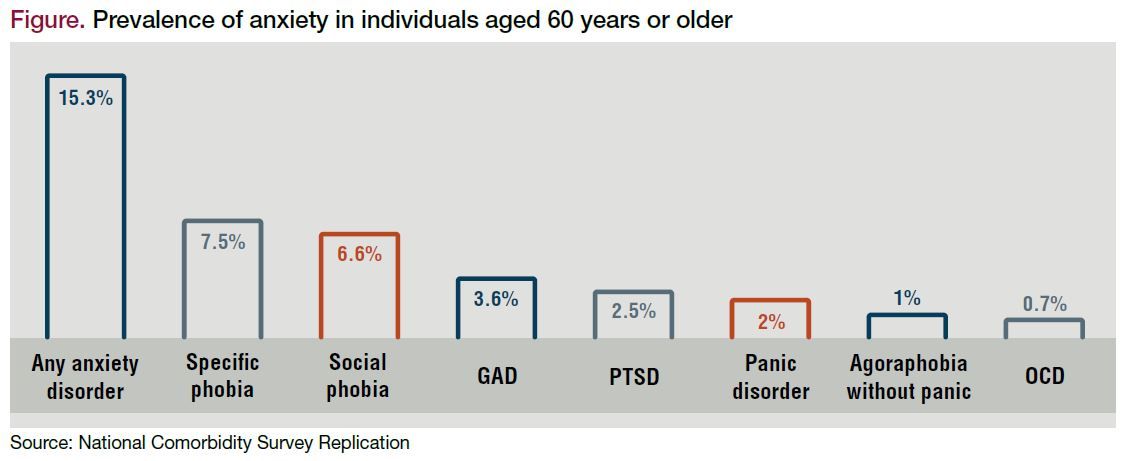News
Article
Psychiatric Times
The Most Prevalent Psychiatric Disorder in Older Adults
The development of specific diagnostic criteria that are applicable to older adults can aid in the accurate diagnosis of psychiatric disorders in late life.
Mrmohock/AdobeStock

Available data indicate that anxiety disorders are the most prevalent of psychiatric disorders among older adults.1 The National Comorbidity Survey Replication (NCS-R) found that among individuals aged 60 years or older, the prevalence of any anxiety disorder was 15.3% with specific phobia being the most prevalent: 7.5%; followed by social phobia: 6.6%; generalized anxiety disorder (GAD): 3.6%; PTSD: 2.5%; panic disorder: 2%; agoraphobia without panic: 1%; and OCD: 0.7% (Figure).2
The risk factors for anxiety among older adults can be divided into external and internal factors. The external factors (ie, stress factors) include chronic medical illnesses, disability, and major illness in a spouse; internal factors (ie, vulnerability factors) include personality traits of neuroticism and low self-efficacy.
Among older adults, anxiety disorders are associated with reduced physical activity and functional status, poorer self-perceptions of health, decreased life satisfaction, increased loneliness, decreased quality of life, increased service use, and the overall greater cost of care. Anxiety disorders are also a risk factor for Alzheimer disease and vascular dementia.3
Assessment
Despite their prevalence, anxiety disorders among older adults are under-recognized and poorly treated. Among older adults, primary care physicians correctly made the diagnosis of any anxiety disorder in approximately 9% of the older adults.4 The most common reason for poor recognition the physical symptoms associated with anxiety disorders (eg, sleep disturbances, fatigue, restlessness, difficulty concentrating) tend to overlap with medical disorders commonly seen among older adults. Current diagnostic criteria for anxiety disorders were developed for use in younger individuals and are not sensitive to detecting these disorders in older adults, which further complicates recognition. And, these disorders often co-occur with depression, substance use disorders, and cognitive disorders among older adults, which makes the correct diagnosis more complex.
The initial step in evaluating older adults who present with symptoms of an anxiety disorder is to get a thorough history. Because anxiety disorders in older adults are highly comorbid with cognitive disorders, information from a collateral source is essential to clarify the history of symptoms. Eliciting history is often followed by a mental status examination and formal cognitive testing.
The next step is to assess for comorbid disorders (eg, depression, psychosis, cognitive dysfunction) and treat them. A focused physical examination and laboratory testing should also be completed to rule out co-occurring medical illness and adverse effects of prescribed drugs or drugs of abuse.
Although not specifically developed for use among older adults, standardized rating scales help with qualifying and quantifying the symptoms of anxiety. These rating scales can be divided into self-report scales and clinician-rated scales. The commonly available self-reported scales include the Worry Scale (WS), the State-Trait Anxiety Inventory (STAI), the Penn State Worry Questionnaire (PSWQ), Padua Inventory (PI), and the Beck Anxiety Inventory (BAI).5 Clinician-rated scales include the Structured Clinical Interview for DSM (SCID), the Diagnostic Interview Schedule (DIS), the Anxiety Disorders Interview Schedule (ADIS-R), and the Hamilton Anxiety Rating Scale (HARS). In cases in which anxiety disorders are comorbid with other psychiatric disorders including mood disorders, psychotic disorders, personality disorders, and/or cognitive disorders, neuropsychological testing may be very useful in making the appropriate diagnoses and developing subsequent treatment plans.
Prevention and treatment
Findings indicate that a stepped-care program reduces the 12-month and 24-month incidence of depressive and anxiety disorders by one-half of the usual care, and it is cost-effective.11-13 With this care model, older individuals sequentially receive a watchful waiting approach, cognitive behavioral therapy (CBT)-based bibliotherapy, cognitive behavioral therapy-based problem-solving treatment, and a referral to a primary care clinician for medication management as needed.
A meta-analysis of non-pharmacological interventions for late-life anxiety in 495 patients found that psychological interventions were more effective than no treatment on both self-rated and clinician-rated measures of anxiety with an effect size of 0.55.6 A meta-analysis that evaluated the efficacy of CBT alone, CBT with relaxation training, and relaxation training alone for late-life anxiety found that treatments were more effective than active control conditions.7 The researchers also found that CBT (alone or augmented with relaxation training) did not seem to add anything beyond relaxation training alone.
Data from 10 randomized controlled trials (RCTs) of antidepressants for late-life anxiety demonstrated that antidepressant use was associated with a significant reduction in anxiety symptoms at the end of the study period, but the trials predominantly included patients with generalized anxiety disorder (GAD) and there were limited data regarding the long-term use of antidepressants for anxiety.8
In a soon to be published systematic review, Gupta and colleagues9 identified 5 RCTs that used benzodiazepines for treatment of anxiety disorders among older adults. They found that benzodiazepine use was associated with decreased anxiety at the end of each study period. Tolerability data showed mild adverse effects from the use of benzodiazepines. The main short comings of the study were limited data on the long-term use of benzodiazepines for anxiety and that the majority of the trials evaluated the use of benzodiazepines for GAD. Benzodiazepines should be used cautiously among older adults given their significant adverse effect profile including dependence, cognitive difficulties, and falls.10
In their RCT, Wetherell and colleagues11 sequenced treatment with pharmacotherapy and CBT for patients with GAD who were aged 60 or older. These individuals initially received 12 weeks of open-label escitalopram treatment. The researchers found that patients who received escitalopram augmented with CBT had improved response rates on the Penn State Worry Questionnaire compared with patients who received escitalopram alone. They also found that both escitalopram and CBT prevented relapse compared with placebo.
Conclusions
Anxiety disorders are not uncommon among older adults, but they are often underdiagnosed or misdiagnosed. And, they are associated with significant comorbidity and mortality among older patients. The development of specific diagnostic criteria that are applicable to older adults can aid in the accurate diagnosis of these disorders in late life. Psychotherapy that includes relaxation training and pharmacotherapy have been found efficacious for anxiety disorders among older adults.
Dr Tampi is Chairman, Department of Psychiatry & Behavioral Sciences, Cleveland Clinic Akron General, Akron, OH; Chief, Section for Geriatric Psychiatry, Cleveland Clinic, Cleveland, OH; and Professor of Medicine, Cleveland Clinic Lerner College of Medicine, Case Western Reserve University, Cleveland, OH. Ms Tampi is Executive Vice President, Diamond Healthcare, Richmond, VA. The authors report no conflicts of interest concerning the subject matter of this article.
References
1. Olfson M, Broadhead EW, Weissman MM, et al. Subthreshold psychiatric symptoms in a primary care group practice. Arch Gen Psychiatry. 1996;53:880–886.
2. Kessler RC, Berglund P, Demler O, et al. Lifetime prevalence and age-of-onset distributions of DSM-IV disorders in the National Comorbidity Survey Replication. Arch Gen Psychiatry. 2005;62:593-602.
3. Becker E, Orellana Rios CL, Lahmann C, et al. Anxiety as a risk factor of Alzheimer’s disease and vascular dementia. Br J Psychiatry. 2018;213:654-660.
4. Calleo J, Stanley MA, Greisinger A, et al. Generalized anxiety disorder in older medical patients: diagnostic recognition, mental health management and service utilization. J Clin Psychol Med Settings. 2009;16:178-185.
5. Tampi RR, Tampi DJ. Anxiety disorders in late life: a comprehensive review. Health Aging Res. 2014;3:14.
6. Nordhus IH, Pallesen S. Psychological treatment of late-life anxiety: an empirical review. J Consult Clin Psychol. 2003;71:643-651.
7. Thorp SR, Ayers CR, Nuevo R, et al. Meta-analysis comparing different behavioral treatments for late-life anxiety. Am J Geriatr Psychiatry. 2009;17:105-115.
8. Balasubramaniam M, Joshi P, Alag P, et al. Antidepressants for anxiety disorders in late-life: a systematic review. Ann Clin Psychiatry. 2019;31:277-291.
9. Gupta A, Bhattacharya G, Farheen SA, et al. Systematic review of benzodiazepines for anxiety disorders in late life. Ann Clin Psychiatry. 2020;32:114-127.
10. Markota M, Rummans TA, Bostwick JM, Lapid MI. Benzodiazepine use in older adults: dangers, management, and alternative therapies. Mayo Clin Proc. 2016;91:1632-1639.
11. Wetherell JL, Petkus AJ, White KS, et al. Antidepressant medication augmented with cognitive-behavioral therapy for generalized anxiety disorder in older adults. Am J Psychiatry. 2013;170:782-729. ❒







